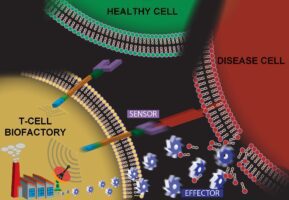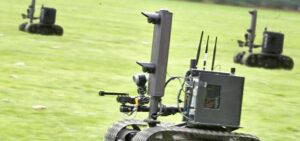Press
-

Engineering a Living Drug Factory
As the immune system’s equivalent of guided missiles, T-cells offer a seemingly ideal approach to disease management. They actively locate diseased cells and, after arriving at their target, exert a therapeutic effect proportionate to the disease burden. Unfortunately, many diseases such as cancer, autoimmune disorders and viral infections have immunological roots, and have become proficient…
-

The Future of Augmentation
The “Mother of All Demos” on December 9, 1968 was a truly seminal event. Doug Engelbart and his SRI team introduced to the world forms of human-computer interaction that are now ubiquitous: a screen divided into windows, typing integrated with a pointing device, hypertext, shared-screen teleconferencing. While these innovations have had enormous impact, they are…
-

From Toys to Trust – The Internet of Critical Things
When you hear someone talk about the Internet of Things (IoT), you may be thinking about toys and smart lightbulbs. The concept of IoT includes many more application areas, including manufacturing, energy, finance, health care, transportation and other things that we depend on for our everyday lives and wellbeing. People need to be able to…
-

Early Findings of Research on Apple and ConnectED Initiative to Improve Learning Through Technology in Low-Income Schools
Many in the education community celebrate the potential of technology to help prepare students for the future. But realizing that potential depends on how educational technology tools are used, an area in which gaps persist on average between high-poverty schools and their better-resourced peers. An important goal is to introduce new technologies in ways that…
-

Launching Drishti: Continuing SRI’s human-centric legacy with AI in the factory
By Prasad Akella, Founder and CEO, Drishti The next time you come to a meeting at SRI International’s headquarters, arrive early. Linger in front of the glass-enclosed exhibit that lines the lobby’s left wall. It contains descriptions and artifacts from SRI’s storied history, arranged thematically from the 40’s to today. You’ll learn about everything from radar…
-

Finding Competitive Advantage in a Technology Equal World
SRI is proud to welcome all the attendees of the annual Army Training and Doctrine Command (TRADOC) Mad Scientist Conference to SRI headquarters in the heart of Silicon Valley. The theme of this year’s conference, “Bio Convergence and the Soldier 2050,” will address emerging and future scientific advances and technology developments to improve capabilities and…
-

Can Innovative School Models Improve Outcomes for Youth Who Are Currently Off Track to Graduate?
Despite rising high school graduation rates, 4.9 million young adults between the ages of 16 and 24—or 12.3 percent of U.S. youth—were neither working nor in school in 2015. There is a clear and pressing need to support students before they drop out of high school, and to reengage those who are no longer enrolled.…
-

Managing Information Overload with Text Analytics
No scientist or researcher can keep current with the vast number of potentially relevant journal articles and technical documents published each year in a given field. As with many problems involving overwhelming amounts of information, computers and advanced machine learning/artificial intelligence tools offer a potential solution. Text analytics can be applied to entire document sets…
-

Arecibo Observatory Active in Puerto Rico Recovery
The Arecibo Observatory has withstood the wrath of Hurricane Maria. I am happy to say that all the staff members and their families are safe and accounted for. The staff has spent the past week performing cleanup activities as well as inspecting the physical structures and the research equipment. The Observatory sustained less damage than…
-

New Cyberlearning Research Publication Highlights Possibilities for Enhanced Learning with Technology
In the field of education research, a core focus has been the impact of digital learning technologies in K-12 and higher education settings – and SRI’s Education Division has been at the forefront of much of that research.
-

Early Lessons Launching Open Education Resource Degrees in Community Colleges
SRI recently released our first report on the Open Education Resource (OER) Degree Initiative, an effort led by Achieving the Dream (ATD), a network of more than 200 community colleges, to boost college access and student success. The program supports the redesign of courses needed for a degree using OER materials in place of proprietary…
-

The Mad Science behind Autonomy and AI in the Military
While the U.S. military is laser focused on day-to-day operations, it always has an eye on the future. More specifically, on how to encourage innovation and leverage technologies, products and approaches that can better ensure mission success. This past spring I had the pleasure of speaking at the Mad Scientist Conference on Robotics, Artificial Intelligence…